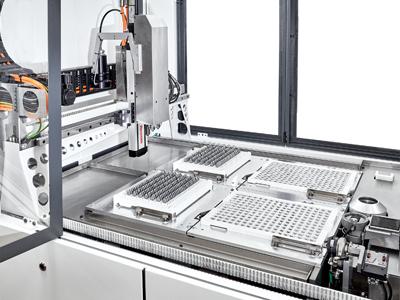
AGATHON Machine Tools Inc. has introduced the new Leo Peri 4-axis grinding center for grinding the periphery of indexable inserts.
Throughout product development, the Leo Peri design concept focused on achieving a smaller machine size, incorporating greater user friendly accessibility, maintenance free concepts, and overall superior machine strength enabling high process performance to meet both high production and peak quality standards for carbide, cermet, ceramics and PCBN applications.
Specific features include: fully integrated 3-axis linear handling system, state-of-the-art control technology, optimized direct drives for X, Y and C axes, in-process dressing, 250 mm grinding wheel diameter and support for utilizing 4 to 6 standard pallets for more flexibility and greater efficiency. With the Leo Peri’s small footprint (4 sq. meters) combined with short grinding times, high removal rates and low power consumption, result in low cost per workpiece while meeting stringent quality and precision performance standards over a broad range of materials.
In addition, the machine layout incorporates easy access from three sides only allowing for back-to-wall or back-to-back installation as well as allowing for uncomplicated servicing. The centralized layout of all machine connection points is another feature for ease of operation. Peripheral devices can utilize roof-top installation for enhanced space usage.
Options include: Vision system with LED luminous field and/or spot recognition; integrated cooling lubricant lift pump; force measurement, software for easy program creation for ISO inserts as well as other software options.
Contact Details
Related Glossary Terms
- ceramics
ceramics
Cutting tool materials based on aluminum oxide and silicon nitride. Ceramic tools can withstand higher cutting speeds than cemented carbide tools when machining hardened steels, cast irons and high-temperature alloys.
- dressing
dressing
Removal of undesirable materials from “loaded” grinding wheels using a single- or multi-point diamond or other tool. The process also exposes unused, sharp abrasive points. See loading; truing.
- grinding
grinding
Machining operation in which material is removed from the workpiece by a powered abrasive wheel, stone, belt, paste, sheet, compound, slurry, etc. Takes various forms: surface grinding (creates flat and/or squared surfaces); cylindrical grinding (for external cylindrical and tapered shapes, fillets, undercuts, etc.); centerless grinding; chamfering; thread and form grinding; tool and cutter grinding; offhand grinding; lapping and polishing (grinding with extremely fine grits to create ultrasmooth surfaces); honing; and disc grinding.
- grinding wheel
grinding wheel
Wheel formed from abrasive material mixed in a suitable matrix. Takes a variety of shapes but falls into two basic categories: one that cuts on its periphery, as in reciprocating grinding, and one that cuts on its side or face, as in tool and cutter grinding.
- polycrystalline cubic boron nitride ( PCBN)
polycrystalline cubic boron nitride ( PCBN)
Cutting tool material consisting of polycrystalline cubic boron nitride with a metallic or ceramic binder. PCBN is available either as a tip brazed to a carbide insert carrier or as a solid insert. Primarily used for cutting hardened ferrous alloys.
- vision system
vision system
System in which information is extracted from visual sensors to allow machines to react to changes in the manufacturing process.
